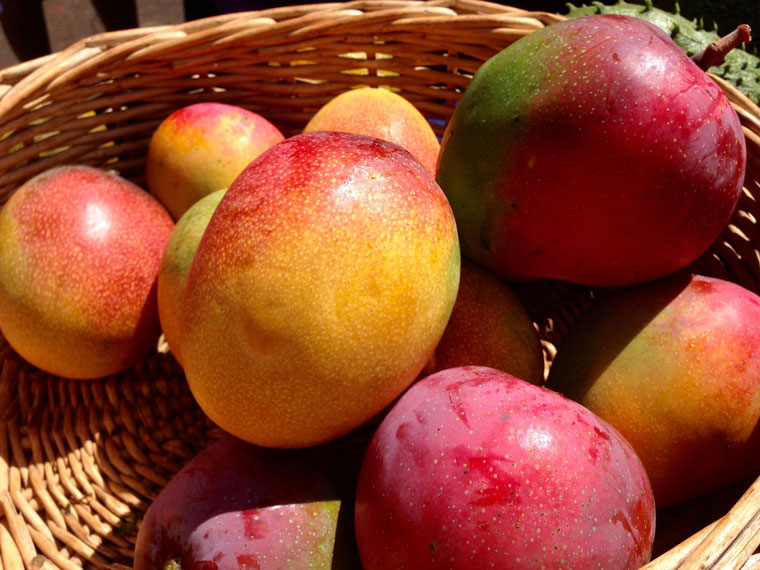Kauai Mango Season

Right now, scent of mangoes cling to the thick air at Kauai farmers markets. Typically, mango season in Hawaii varies on climate conditions, but they usually begin ripening in April and are available throughout October. Flowering begins in early spring when showy clusters, which grow up to 16-inches long, cascade down trees that grow up to 100 feet tall.
Use your sense of smell and touch when shopping for ripe mangoes. Skin color varies widely, so that is not an accurate indication of ripeness. All ripe mangoes should have a mild, fruity aroma, especially at the stem end, and they should yield to gentle pressure. Avoid soft, bruised or wrinkled fruit.
When ripe and depending on the variety, skin color can range from green to blush, to crimson over a deep yellow under-color. Inside, the flesh is bright yellow or orange. If it’s a good one, the flesh is silky, sweet and extremely juicy.
Mangos like warm, dry growing conditions. Too much moisture can leave black dots on the skin, which does not penetrate the flesh. If you see a black-speckled mango at the market, go ahead and buy it.

Firm ripe mangoes should be stored at room temperature for up to one week.
Firm ripe mangoes should be stored at room temperature for up to one week. Fully ripe fruit will store in the refrigerator for an additional week.
The first documented date of when mangoes were introduced to Hawaii is in 1824, when Captain Meek of the brig Kamehameha brought small mango plants from Manila. These were divided between Don Marin, a horticulturist in Honolulu, and Reverend Goodrich, a missionary in Wailuku, Maui.
Original wild mangoes were small fruits with scant, fibrous flesh, and it is believed that natural hybridization has taken place in Southeast Asia. Selection for higher quality has been carried on for an estimated 6,000 years and more than 500 varieties have been named in India.
The College of Tropical Agriculture and Human Resources at the University of Hawaii lists more than 100 varieties of mangoes, but only 31 are recommended for commercial or home garden use. More than 500 varieties of manakō, or mango, grow in Hawaii.
Haden and Rapoza are two popular varieties on Kauai. Rapoza is a high-quality cultivar developed by the Department of Horticulture (DOH) at the University of Manoa. It was named after Herbert Rapoza, an employee at the DOH’s Poamoho Experiment Farm. In 1985, the Rapoza was selected from an open-pollinated Irwin seedling grown at the farm.
Named after Captain John J. Haden in 1910, the Haden mango originated in Florida from a Mulgoba seedling from India. The fruit is mild in flavor with a small amount of fiber.
Mango peel and sap contain urushiol, the same chemical found in poison ivy and poison sumac, and causes contact dermatitis in some people. There are two kinds of contact dermatitis: irritant or allergic. For those who are allergic, skin become red, sore, itchy, or inflamed after direct contact. Wash the area right away and apply emollients, or moisturizers. It should clear up without in two or three weeks. Call you doctor if symptoms are severe. Mangoes are washed after harvest, but it’s best to wash the again before handling.

Once you have two “cheeks,” score their centers in a crosshatch pattern and scoop the flesh out with a spoon
Mangos have a large flat seed in the center of the fruit, which clings tightly to the flesh. When you hold up a mango, you’ll see that two sides are not as plump as the other two. The plump side is where most of the flesh is. Begin about 1/2-inch from the stem and slice through one side. Repeat with the other side. If you run into resistance, that’s the seed. Just move your knife a little further from the center.
Once you have two “cheeks,” score their centers in a crosshatch pattern and scoop the flesh out with a spoon. Gently peel the skin from the remaining centerpiece and eat the flesh from the seed. This is the best part for many people. I just score the edges with my knife in 1/2-inch notches and cut the flesh into a waiting bowl.
Every year, during the peak of mango season, the Waipa Foundation hosts the Mango & Music Festival, where local farmers sell a diverse variety of mangoes.
Mangoes can be slipped into appetizers, soups, salads, entrees, and desserts. You can use them to make a thick curd, luscious pie, snack bread, ice cream, sorbet, juice, dressing, salsa, jam, jelly, preserve, pickle, relish, or chutney. Some people enjoy pickled green mango, or green mango with shoyu and vinegar.
Click here for recipes, or here to register for an intimate Kauai Farmers Markets Food Tour.


